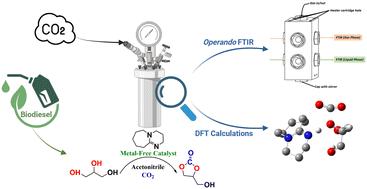揭示从甘油和二氧化碳到碳酸甘油的有机催化途径:一项使用相行为、高压FTIR和DFT见解的综合研究
IF 4.2
3区 化学
Q2 CHEMISTRY, PHYSICAL
引用次数: 0
摘要
研究了以乙腈为脱水剂,DBU为催化剂,由甘油和CO2直接合成碳酸甘油的反应机理。DFT模型显示,最有效的途径是在二氧化碳和甘油的仲醇之间形成C-O键。催化剂降低了各个步骤的能量障碍,特别是对于限速的分子内环闭合,使得羰基取代途径比羟基脱水更有利。然而,与直接羰基化相比,乙腈的水解被证明是不太有效的脱水剂,因为它的能垒更高。虽然CO2压力和乙腈体积等反应参数对产率的影响很小,但它们对甘油转化率有影响。较高的压力和较大的乙腈体积降低了甘油的转化率,但不改变碳酸甘油的收率。升高的温度和延长的反应时间促进了副产物的形成,主要是单乙酰素。在压力和温度的驱动下,反应的复杂相行为表明,只有在特定条件下(155℃,45 bar),甘油和乙腈才能完全混溶。原位FTIR和HPLC分析确定了碳酸甘油、乙酰和乙酰胺的动力学谱,在气相中检测到氨和尿素。互补DFT计算证实,单乙酰素的形成主要来自于甘油和乙酰胺的反应,这一途径的特征是能量势垒最低,与实验结果一致。本文章由计算机程序翻译,如有差异,请以英文原文为准。

Unveiling the organocatalytic pathway to glycerol carbonate from glycerol and CO2: a comprehensive study using phase behavior, operando high-pressure FTIR, and DFT insights†
The direct synthesis of glycerol carbonate from glycerol and CO2, using acetonitrile as a dehydration agent and DBU as a catalyst, was investigated to identify the mechanism involved during this reaction. DFT modeling revealed that the most efficient pathway involves forming a C–O bond between CO2 and glycerol's secondary alcohol. The catalyst reduces energy barriers across steps, particularly for the rate-limiting intramolecular ring closure, making the carbonyl substitution route more favorable than hydroxyl dehydration. However, acetonitrile's hydrolysis proved less effective as a dehydrating agent due to its higher energy barrier compared to direct carbonylation. While reaction parameters like CO2 pressure and acetonitrile volume had minimal impact on yield, they influenced glycerol conversion. Higher pressure and larger acetonitrile volumes reduced glycerol conversion without changing the yield of glycerol carbonate. Elevated temperatures and prolonged reaction times promoted the formation of side products, primarily monoacetin. The reaction's complex phase behavior, driven by pressure and temperature, revealed that glycerol and acetonitrile become fully miscible only under specific conditions (155 °C, 45 bar). In situ FTIR and HPLC analyses identified kinetic profiles for glycerol carbonate, acetins, and acetamide, with ammonia and urea detected in the gas phase. Complementary DFT calculations confirmed that monoacetin formation predominantly arises from the reaction of glycerol with acetamide, a pathway characterized by the lowest energy barriers, aligning with experimental findings.
求助全文
通过发布文献求助,成功后即可免费获取论文全文。
去求助
来源期刊

Catalysis Science & Technology
CHEMISTRY, PHYSICAL-
CiteScore
8.70
自引率
6.00%
发文量
587
审稿时长
1.5 months
期刊介绍:
A multidisciplinary journal focusing on cutting edge research across all fundamental science and technological aspects of catalysis.
Editor-in-chief: Bert Weckhuysen
Impact factor: 5.0
Time to first decision (peer reviewed only): 31 days
 求助内容:
求助内容: 应助结果提醒方式:
应助结果提醒方式:


